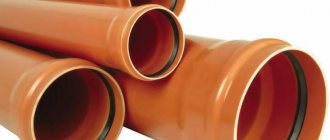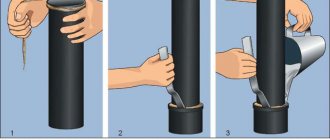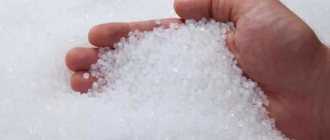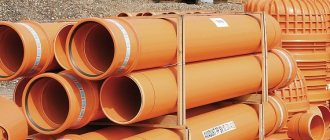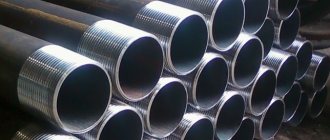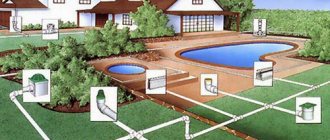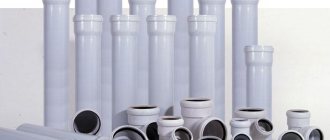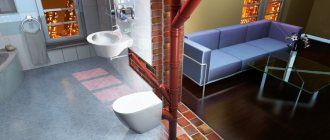Hello, friends! Sewer lines may run in hard-to-reach places where there is not enough free space to carry out work. If you lay ordinary pipes, for example plastic or cast iron, you will have to add more joints and buy additional fittings, as a result of which not only the cost of the system increases significantly, but also the risk of leaks.
Corrugated sewer pipe is more flexible and easy to use; with its help you can quickly install a sewer system anywhere.
Device
A corrugated pipe is a hollow, elongated product with a circular cross-section, the outer surface of which consists of ridges and grooves alternating at equal distances, and the inner surface is smooth. The distance between the ridges and their size may vary between different manufacturing companies; the degree of rigidity is adjusted by changing the thickness of the rings.
Characteristics
Corrugated pipes are made from a special polymer, the features of which also affect the technical characteristics of such products:
- Nominal diameter DN – from 110 to 1200 mm.
- The color of the outer surface is black or orange-brown.
- Ring stiffness indicator - for pipes with DN less than 500 mm: SN4; SN8 or SN16; for products with DN more than 500 mm: SN2; SN4; SN8 or SN16.
- Impact strength - TIR≤10%.
- Ring flexibility at 30% deformation - no cracks, wall delaminations, kinks or warping.
- Installation temperature - up to -20ºС.
- Change in length and appearance after overheating - from 2 to 5%.
- The Vicat softening point is not less than 76ºС.
- Depth of occurrence (depending on the parameter of ring rigidity) - from 1 to 15 m.
- The warranty period is at least 50 years.
Using double-layer corrugated pipes for storm drainage system
Storm drainage is a non-pressure system of channels and devices for collecting, filtering and draining precipitation and melt water. In most cases, these are grid-covered rain collectors - two-layer corrugated pipes through which precipitation is directed to a well or collector. It is better to select rain collectors with a hole for attaching pipes, which allows for faster movement of wastewater. It is preferable to lay a corrugated sewer pipe with a slope of 1%, that is, 1 cm per 1 m of pipe. To prevent sewer pipes from freezing, they are installed below the soil freezing level. The part of the pipe that is in the freezing zone is wrapped with insulation so that subzero temperatures do not arise inside. Depending on the amount of precipitation in the region, the size of corrugated pipes for storm drainage ranges from 110 mm to 210 mm.
Laying corrugated pipes in the ground on a sand bed
Application area
Corrugated sewer pipes are designed for long-term operation and, depending on their degree of resistance to physical stress, are used for laying communications:
- Lightweight corrugated pipes with low mechanical stability - for the installation of external sewer systems. In addition, lightweight flexible corrugation is used as protective boxes for low- and high-voltage cables of power and communication lines.
- Heavy corrugated pipes that have an average level of mechanical strength are used for underground installation of drainage lines for domestic and industrial wastewater, rainwater, drainage systems, and storm sewers.
- Extra-heavy corrugated pipes, which have high mechanical resistance, are used in places where sewer lines pass under roads or railway tracks.
Characteristics and types of polymer corrugated pipes
The most important properties of corrugated pipes, which are indicated in their technical description, are:
- 1. External diameter;
- 2. Inner diameter;
- 3. Ring stiffness coefficient.
The latter is denoted by the English abbreviation SN (stiffness nominal) and is measured in kilonewtons per m2. The most common coefficients are SN4, SN8 and SN16. It is accepted that the coefficient is always a power of 2. Depending on the stiffness rating, all pipes are divided into light (SN2), heavy (SN4 and SN8) and extra heavy (SN16, SN32, etc.).
Lightweight corrugated pipes with a diameter of up to 200 mm are placed in open areas and in hollow building structures. Heavy pipes are laid in ditches in sandy and clayey soils. Extra-heavy pipes with a diameter of 400 mm or more are intended for laying in rocky soils and in areas with movement and winter frost heaving.
It is also recommended to install corrugated hoses of increased rigidity in concrete and stone walls and concrete foundations, which are subject to inevitable shrinkage after the building is put into operation. In addition, increased strength of utilities is needed when installing pipelines for moving hot and caustic liquids, as well as wastewater, in order to avoid contamination of the area.
Installation of corrugated pipes may be required in industrial production to protect communications from negative technogenic influences (high temperatures, thermal compression and expansion, water hammer, vibration).
The final type and size of the corrugated hose is determined based on the mode and purposes of operation, the expected throughput and the characteristics of the medium moved through the pipes.
Suppliers and manufacturers in Russia
- Products Pragma Manufacturer Russia. They are highly resistant to shock loads. Resistant to low temperatures.
- Products Polytron Manufacturer Serbia. It has high ring rigidity. Resistant to chemical influences.
- Products Corex Manufacturer Belarus. Resistant to chemical influences. Used to drain cold and hot water.
- Products Corsis Brand Italy. High ring stiffness. Resistant to temperature changes. Resistant to chemical influences.
- Products Corsis Eco Manufacturer Russia. Made from recycled materials. Applicable in systems without high load. They are distinguished by their low price.
- Magnum products Concern SYSTEM GROUP, Italy. It has high ring rigidity. Resistant to chemical influences. Resistant to temperatures below -40.
- Products FD-plast Manufacturer Russia. They are distinguished by their low price. Resistant to aggressive chemical environments. Resistant to low temperatures. High ring stiffness.
Classification and types
Corrugated sewer pipes are divided into several types, depending on the type of plastic used for their manufacture and the structural features of the wall.
According to the wall structure, corrugated pipes are divided into:
- Single-layer - products of increased flexibility, the wall is structured on the outside and inside. They have insufficient strength and are prone to clogging due to the uneven inner surface, so their scope of use is limited to protective casing for electrical wiring and drain hose of household appliances, for example, a washing machine or dishwasher.
- Two-layer - have a more complex wall structure: the inner layer is smooth, and the outer wall is corrugated. Double-layer pipes are more durable, resistant to any type of mechanical stress, and can withstand the pressure of soil or concrete mass.
- Reinforced - with a steel layer, which increases the ring rigidity of plastic corrugated pipes many times. The metal insert is located under a layer of plastic, so the product is no less resistant to corrosion than other types of polymer pipes.
- Perforated - with a two-layer wall structure and evenly distributed holes over the surface of the entire product. They are used to organize drainage systems in construction and agriculture.
For the production of sewer corrugated pipes the following is used:
- Polyvinyl chloride (PVC).
- Low-density polyethylene (HDPE).
Both types of rolled pipes are included in the group of polymer materials, but differ in their structure and a number of performance properties.
Products made of polyvinyl chloride
Corrugated pipes made of PVC and unplasticized polyvinyl chloride (UPVC) can withstand heavy loads and can be used both for the installation of external sewer networks and for their underground installation and passage through reinforced concrete structures. They are inert to chemical influences, do not corrode in a humid environment, are durable, and can withstand working environment temperatures in the range from -40ºС to +50ºС for a long time, and up to +90ºС for a short time. The disadvantages of PVC pipes include low frost resistance; when the ambient temperature drops below the permissible limit, they become fragile. When heated to too high temperatures, polyvinyl chloride releases toxic elements.
Polyethylene products
An alternative to PVC products is corrugation made of low-density polyethylene, the outer layer of which is made of structured HDPE, and the inner layer of smooth LDPE. Such products bend well, do not stretch, withstand compressive and tensile loads, are resistant to water hammer, have anti-corrosion properties, biological and chemical resistance. Their operating temperature range is from -50 to +120 degrees. When liquid freezes in pipelines, HDPE corrugated pipes will not burst, since the material has the ability to expand by 5-7%. After defrosting, the pipes regain their original shape and size. HDPE corrugation is used for the installation of pressure sewers, storm sewer lines, for drainage and in filtration fields. The only disadvantage of such products is their higher cost compared to polyvinyl chloride corrugation.
Features of sewerage installation using corrugated pipes
The installation of an autonomous sewer system is carried out in accordance with the standards of the current SNiP. Installation of a corrugated pipeline is carried out in several stages.
A trench is laid between the house and the pit under the sewer well. To do this, dig a ditch with inclined slopes 25-50 cm wide. The distance between the outer wall of the pipe and the wall of the trench should be at least 20 cm.
The bottom of the trench is inspected for the absence of obstacles in the form of boulders, and leveled in such a way that when laying drainage lines, it can withstand a slope of 2 cm per linear meter. This is necessary in order to ensure the correct functioning of the gravity system.
To create a solid foundation, the bottom of the trench is carefully compacted, constructing a sand or gravel “cushion” up to 20 cm high.
When lining the sand and gravel layer, small depressions are made in the intended locations of the bell.
The corrugation is laid manually, carefully compacting the cavities between the walls of the structure and the bottom of the pit. The pipes are placed so that the sockets point in the opposite direction relative to the slope.
When laying pipeline elements, it is necessary to ensure that the concrete mixture or soil embankment adheres tightly to it. If it is laid over voids, there is a high risk of deformation of structural elements after the system is launched.
All joints are thoroughly cleaned and sealed with rubber rings.
The sealing rings are placed in such a way that the profile of the seal is directed in the direction opposite to the line where the pipe enters the socket.
Elements with a diameter of 110 mm to 800 mm are connected using a socketless method using special couplings. Pipelines with a diameter of 315 mm and above are connected through funnel-shaped extensions - sockets. When connecting corrugated polymer pipes with other materials, special adapter fittings are used.
In some cases, the welding method is used to connect elements end-to-end. The work is performed with a welding machine designed for ordinary polyethylene pipes. To obtain a uniform and sealed seam, the end sections are heated to a temperature at which the polymer material begins to melt, and then connected under a set pressure.
The trench is filled with sand, lining a layer 8-10 cm thick. The embankment is compacted only along the side walls of the trench. Finely graded crushed stone can also be used for backfilling.
The top layer of the sand embankment is lined with ordinary soil removed when digging a ditch. To create a uniform embankment, the soil is first cleared of stones and large lumps.
The process of installing corrugated pipes for sewerage is not particularly difficult, but it is better to entrust the development of the system design and the selection of materials to specialists.
Advantages and disadvantages
Corrugated pipe products, regardless of the material of manufacture, have the following advantages:
- Light weight, facilitating the process of transporting, storing and laying such products.
- High flexibility. The corrugation is capable of bending in any direction, so when laid, it can bend around obstacles in areas with complex terrain with a small number of connecting elements.
- Corrosion resistance. Corrugated pipes of all types are resistant to corrosion in a humid environment.
- They are simply laid without the use of lifting equipment or additional equipment.
- High ring rigidity and mechanical strength, thanks to which they can be used for underground installation and concreted in building structures.
- High throughput. Rolled pipes with a smooth inner surface transport the working substance with minimal friction, so the walls of pipelines made of corrugated pipes are not subject to biofouling and significant deposits that narrow the flow area.
- Low cost of products, reliability and economical operation.
- Durability. Communications assembled from corrugated pipes will last at least 50-70 years.
Despite the large number of advantages, plastic corrugation also has disadvantages:
- Low frost resistance.
- Increased noise level.
The use of double-layer corrugated pipes for an external sewerage system
External sewerage is very important for the removal of sewage and other waste. There are a number of requirements for corrugated pipes for external sewerage:
- resistance to waste composition;
- strength, environmental friendliness, heat resistance;
- ease of maintenance.
When laying corrugated sewer pipes for external sewerage, the composition of the soil and the flow load are taken into account. Pipe sizes start from 110 mm and above. If the sewer pipe is laid in a green area, then choose a lightweight type; in an area with a small flow of moving traffic - severe; under highways and railway tracks - super-heavy type of pipes. Just when installing corrugated sewer pipes in homogeneous soil, one of their main advantages is visible: the soil fits tightly to the notches of the corrugated profile and the pipe takes a stable position.
Helpful advice! A corrugated pipe for external sewerage is chosen to be a two-layer pipe with a smooth inner surface, painted white or blue. This choice of color helps to quickly find damage and carry out repairs.
When a corrugated pipe is used in a sewerage system, it easily copes with the flow of wastewater and household waste.
Fittings for corrugated double-layer PVC pipes
Product Standards
Requirements for the technical characteristics and dimensions of corrugated pipes made of polymeric materials are established by GOST R 54475-2011 and TU 2248-001-96467180-2008.
Dimensions
Corrugated pipes are sold in lengths of 6 or 12 m and have the following cross-sectional dimensions (Table 1):
Table 1
| Outer diameter, mm | Inner diameter, mm | Wall thickness, mm | Corrugation protrusion width, mm |
| 110 | 91 | 1,0 | 8,6 |
| 125 | 107 | 1,1 | 8,6 |
| 160 | 138 | 1,2 | 9 |
| 200 | 176 | 1,4 | 12 |
| 250 | 216 | 1,7 | 23 |
| 315 | 271 | 1,9 | 27 |
| 400 | 343 | 2,3 | 30 |
| 500 | 427 | 2,8 | 38 |
| 630 | 535 | 3,3 | 47 |
| 800 | 678 | 4,1 | 56 |
| 1000 | 851 | 5,0 | 60 |
| 1200 | 1030 | 5,0 | 80 |
Tips for choosing
The sewer system will function uninterruptedly only if the work on its assembly and installation is carried out correctly, as well as the correct selection of all components. As for pipes, they must be selected according to the following parameters:
- Nominal diameter and wall thickness.
- Length of sections.
- The type of system is pressure and non-pressure.
- Estimated load on the system.
It is better to purchase such products in specialized stores, where the quality of the product is confirmed by an appropriate certificate describing the technical characteristics and a quality certificate. You should also check the integrity of the packaging and the presence of markings on each section of pipe, consisting of:
- Name or trademark of the manufacturer.
- Symbol.
- Dates of manufacture.
approximate cost
The cost of plastic corrugated pipes for sewerage depends on the size of the product, stiffness class, material of manufacture and manufacturer.
Average prices for the most popular two-layer corrugated HDPE pipe with a welded socket are shown in Table 2.
Table 2.
| No. | Outer/inner diameter, mm | Hardness class | Price 1 linear meter, rub. VAT included |
| 1 | 110/94 | SN 8 - SN 9 | 210 |
| 2 | 160/136 | 360 | |
| 3 | 250/216 | 758 | |
| 4 | 230/200 | SN 6 - SN 7 | 512 |
| 5 | 250/216 | 622 |
The best domestic and foreign manufacturing companies
The most famous manufacturers of plastic corrugation for sewerage are the following companies:
- Wawin (Holland).
- PIPELIFE International GmbH (Austria) - Pragma pipes.
- Polieco (Italy) - Corsis PRO sewer corrugation.
- Russian companies - FD-plast, Poliplastik, Politek.
Features of installation and dismantling
The installation of a gravity sewer system is carried out in accordance with the requirements of current SNiP. The laying of a corrugated pipeline is carried out in several stages.
Trench excerpt
A straight trench is dug from the point of exit from the house to the septic tank or central highway with a slope of 7 mm/m. for pipelines with a diameter of 150 mm and 8 mm - for a diameter of 200 mm, turns are allowed only in wells. The width of the ditch must be at least 40 cm greater than the outer diameter of the pipe (20 cm on each side). The depth of its occurrence is calculated based on the thickness of the freezing layer of soil in the region. The bottom of the trench is leveled and compacted.
Sand cushion device
The bottom of the prepared ditch should be filled with sand, a layer thickness of 15-20 cm. The sand cushion will increase the pipe’s resistance to crushing in the event of uneven subsidence of the soil base.
Methods for connecting corrugated pipes
After completing the excavation of the trench and preparing the base, the pipes are connected to each other and laid.
Corrugated pipes can be connected to each other in several ways:
- Coupled - using a coupling and an o-ring. The surfaces to be joined are cleaned of dirt and lubricated with silicone sealant with water-repellent properties. Then a sealant is inserted into the corrugation wave of one of the pipes. For products with a diameter of less than 200 mm, the installation location of the ring is the second wave, for pipes with a larger diameter - the first wave. The ring ensures complete fit of the fitting and guarantees the tightness of the connection.
- Bell-shaped - used for pipes with a diameter of more than 250 mm. The socket is manufactured separately and welded to the end of the pipes at the corrugation production stage. The mounting end of one of the connected sections is inserted into the socket of the subsequent part using silicone grease, and then fixed with an O-ring.
- Butt welding - used for small diameter products. The two ends of the pipes are placed into a special welding machine, in which the ends are melted and connected to each other through the mutual penetration of polymer molecules of both parts into each other.
Backfilling the trench
The sewer pipeline is first filled with sand to a depth of 30 cm with layer-by-layer pouring of water. After this, the ditch is completely filled with soil.
Well installation
Inspection wells are installed every 35 meters in straight sections and rotary wells in places where there is a need to change the direction of the pipeline. To monitor the condition of the sewer network, an inspection or cleaning is installed every 15 m of a straight line.
Corrugated pipes for sewerage
Types of corrugated sewer pipes and their correct installation
Progress affects all aspects of human life, even such conservative ones as the construction of sewer systems. The basis of any sewer system is pipes. Today, a variety of types are used, but the most popular solution is plastic pipes
.
For the installation of external systems, you should prefer sewer corrugated pipes. This type of pipe can also be used for installing drainage systems
or
storm sewers
.
Corrugated sewer pipe is one of the best options for material intended for assembling external networks of domestic sewerage and drainage systems. A two-layer corrugated pipe has increased mechanical strength, since its outer layer is a series of stiffeners.
And inside the corrugated sewer pipe is absolutely smooth, so no additional hydraulic resistance is created when the flow moves.
What are corrugated pipes?
For the manufacture of this type of pipe, a polymer is used that has a high level of resistance to chemical attack and resistance to impact loads. Polyethylene is able to withstand high abrasion loads, so the pipes have a long service life. In terms of strength, such pipes are superior to metal-plastic products.
To assemble heating systems, corrugations for metal-plastic pipes can be used. This version of pipes is made from PVC; it has a broach inside in the form of a probe made of metal wire with a diameter of 0.9 mm. Therefore, the pipes are strong and flexible.
Types of corrugated pipes
Manufacturers offer various types of corrugated pipes, each type has its own purpose:
- Electrical installation corrugations are characterized by an average degree of flexibility and average mechanical stability.
- Single-layer corrugated pipe, characterized by great flexibility and lightness. Such pipes are used as protection for gas pipelines and cable laying.
- Double-layer corrugated hoses are used for laying cables in places where there is a high risk of damage.
- Double-layer corrugated pipes, characterized by high resistance to mechanical and chemical influences. Used for installation of sewerage pipelines.
Dimensions
Corrugated pipes for external sewerage have different sizes. Most often, you can see PVC sewer pipes on sale. They are produced using an extruder. The sizes of PVC products are presented in the range from 11 to 1600 mm. But if pipes are selected for external sewerage, then PVC pipes with a diameter of 50 mm to 160 mm are used.
Polypropylene pipes
are produced using dual extrusion technology, which simultaneously creates a smooth internal and corrugated external surface. For sewer assembly, products with a diameter of 110 mm, 150 mm and 200 mm are most often used.
HDPE corrugated pipe is a flexible product sold in coils. According to GOST, light and heavy pipes are produced from low-density polyethylene. For sewerage in a private house, a pipe with a diameter of 110 mm is often used.
Laying a pipeline from corrugated pipes
When laying a sewerage pipeline, several stages of work can be distinguished:
- preparation of trenches;
- pipe joining;
- backfilling.
Let's take a closer look at the stages of working with plastic.
Trench preparation
Excavation work when laying a sewerage pipeline from corrugated pipes is carried out in accordance with the requirements of SNiP 3.02.01 - 87. Here are the basic rules for their implementation:
- The width of the prepared trenches must be such that the installer, being below, can carry out his work normally. That is, the distance between the side wall of the trench and the wall of the laid pipe should not be less than 20-25 cm.
- After the trench has been dug, you need to carefully examine its bottom. There should be no large stones or frozen areas. Boulders must be removed in advance, and the excavation site must be covered with soil and compacted.
- If the soil on the site is very loose, then measures to strengthen the bottom may be required. Strengthening is carried out by concreting.
- When preparing the trench, the inclination angle specified in the pipeline design should be maintained. If this condition is not met, the gravity sewer will not work normally.
- For any type of soil, a “cushion” for the pipes is provided. Clean sand or fine gravel (grain size up to 20 mm) is used as backfill. The thickness of the bedding layer is 15 cm.
In the places where the pipe sockets will be located, it is necessary to slightly remove the soil of the cushion, constructing so-called pits.
- When installing a pipeline in a private house, pipes can be laid in trenches manually. When constructing central highways, lifting traverses are used for laying.
Pipe connection
How can a corrugated sewer pipe be connected? As a rule, in private construction a pipe socket
. Basic installation rules:
- It is necessary to carry out work on assembling the pipeline in warm weather; the air temperature outside should be above 15 degrees.
- Before starting assembly, it is recommended to inspect the pipes to ensure they comply with the dimensions specified in the project, as well as for the absence of any defects that can be detected visually.
- The pipes should be laid out along the side of the prepared trench, and the pipe sockets should be oriented in the direction opposite to the slope.
- Before starting the connection operation, it is necessary to clean the socket itself and the smooth end of the pipe, removing dust and other contaminants.
- For socket connections, rubber seals must be used. The sealing ring is placed in the groove on the second turn of the corrugation, and care must be taken that the profile of the seal is directed in the opposite direction from the direction of insertion of the pipe into the socket.
- If it is necessary to connect a corrugated pipe with pipeline elements made of other materials ( cast iron pipes
,
ceramic pipes
, asbestos-cement pipes, etc.), it is necessary to use special fittings (
fittings
) - couplings or flanges.
In some cases, instead of connecting into a socket, butt welding of pipes is used. This work is carried out in accordance with the requirements of GOST 16310-80. When welding, the same devices are used that are used to connect simple polyethylene pipes.
The essence of the process is to heat the ends of the pipes until the plastic begins to melt and connect them with a certain pressure. After cooling the plastic, a monolithic seam is formed.
The welding mode is selected depending on the thickness of the pipe walls and the diameters of the elements being welded.
Another connection method is to use an O- ring coupling
. In this case, the seal is installed in the groove of the corrugation:
- For pipe diameters of 250-1200 mm, the ring is inserted into the first groove of the corrugation.
- With a pipe diameter of 125-200 mm - in the second.
When installing the seal, you need to ensure that its profile (“tongue”) is directed in the opposite direction from the end of the pipe.
The connection using couplings is tight and reliable.
backfilling
When backfilling, sand is used first. The layer of sand should be 8-10 cm higher than the pipe. At the same time, the sand should be compacted along the edges of the pipe, but this is not required above the pipe itself.
On top of the sand you can pour the soil that was removed when digging the ditch. It is necessary to ensure that there are no large boulders or large frozen lumps of earth in the backfilled soil.
Polymer corrugated pipes are an almost ideal material for the construction of external pipelines. These may be sewer systems, drainage schemes or storm drains.
Tips for Sewer Pipe Maintenance
To ensure the normal operation of the sewer communication, it is necessary to regularly perform its maintenance. Maintenance means carrying out a set of activities (routine and major repairs, as well as maintenance), during which it is possible to identify all problems in the operation of the system and eliminate them. It consists of performing the following actions:
- Visual inspection of pipelines and wells.
- Regular cleaning and flushing of pipes and septic tank chambers.
- Current or major repairs, during which worn-out sections of pipelines and manholes of inspection wells are replaced. If necessary, well necks are restored, pumping equipment and valves are repaired.
- System leak testing.
Timely implementation of such measures will prevent the occurrence of serious damage to these communications.


